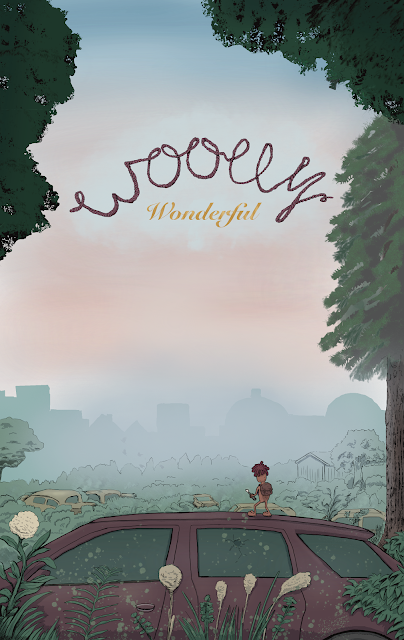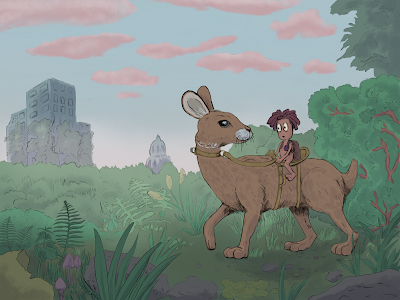Animal Advent Calendar - 3rd Advent
Welcome to the 3rd Advent and back to my Animal Advent Calendar. Today we will be looking at the animal sketches for animals starting with letters I - O.
I for Indri
Indris are the largest lemur and endemic to Madagascar, meaning they only live there. They are also called babakoto in the indigenous language, meaning “ancestor of man”, and are protected from consumption.
As many species they are threatened by logging and habitat loss, leaving the populations strongly fragmented. If the animals don’t find other animals with different gene pools, the gene pool won’t mix well enough making the new generations vulnerable for diseases.
Indris usually live in groups of 2 to 6, a pair with their young. In the morning they can be heard kilometres away in the forest,announcing their presence with wailing, long shouts. Look it up on YouTube, it sounds like a whale over water.
J for Jaguar
Jaguars are big cats from Middle and South America, often confused with the Leopard. Jaguars are more muscular, have shorter and stockier legs and a more orange coat though.
They are true wrestling machines, tackling tapirs, capybaras, pigs, monkeys and deer. With their strong jaws they can even bite through turtle shells and caiman skin. ¡Buen provecho!
Humans worship them as protector of the forest and give them roles in their believes and cultures. Despite this the habitat for the Jaguar is shrinking and it gets in conflict with cattle from commercial farms.
K for Kakapo
Kakapos are the largest and heaviest parrots of the world, living exclusively in New Zealand. Their name means “night parrot”, referring to their nocturnal lifestyle. Like many other birds on New Zealand, e.g. the Kiwi, they lost the ability to fly. Instead they climb trees with the help of their beak.
Being flightless and using stasis as a threat response are not the best traits to counter the many small predators arriving in the last centuries. Humans brought rats and stouts that would sniff out the peculiar smelling bird and diminish their numbers quickly. Only 50 animals were left in 1995. Conservationists brought the remaining animals to small, mammal free islands and started a breeding programme, monitoring every single individual.
Their numbers have risen now to 244 which is still ridiculously low.
L for Leatherback Sea Turtle
The Leatherback turtle is the largest sea turtle in the world, growing up to 2 metres length and a weight of 900 kg.
They are distinct from the other sea turtle species in the fact that they don’t have a hard shell but a leathery skin shell. Their ancestors have existed over 100 million years ago during the dinosaur age and have split up from hard-shelled turtles pretty early.
They travel the longest distances, can dive up to 1200 metres deep, their favourite food being jellyfish. The main reason for their shrinking numbers are plastic bags swimming in the ocean mistaken as jellyfish, habitat loss due to traffic and development on beaches and fishing bycatch.
Their main threat however is egg collection which is sometimes legal in parts of South East Asia or Central America, and has contributed to a great loss in numbers of decades.
Sea turtles have been around for 100 million years, not bad for a slow, gentle reptile. Too bad humans are about to end their existence.
M for Marine Iguana
The marine iguana is the only lizard swimming in the sea in search for food. With their unusual shaped teeth they graze for algae on the sea floor and dive up to 12 metres deep. Having a higher, vertically flat tail helps in swimming and navigating.
It is believed that these reptiles reached the Galápagos Islands on rafts from South America 10 million years ago, as the islands were never attached to the mainland, but the land bridge between these got covered by the ocean eventually.
As all reptiles are cold-blooded and the ocean water is cold, the animals need to bask and heat-up in the sun on the shore before going for a dive. Their dark grey and black skin , with patches of green and red, helps to absorb the sun’s warmth quickly. Once they’ve warmed up enough, they can go into the sea again to feed.
Marine iguanas are a unique species and highly adapted to living in the sea. Excess salt is pushed out through their noses as if they sneeze. It only live on these islands and are vulnerable to changes in water temperature or saline levels like El Niño as this affects their environment. Too hot waters won’t produce enough red and green algae these animals depend on. Climate change might become a threat to them.
N for Numbat
The numbat is a small marsupial from Australia, not closely related to kangaroos or koalas, but its closest relative was the now extinct Tasmanian wolf or Thylacine.
They look a bit like a small anteater or a British squirrel and are sometimes also called banded anteater. Funny enough, they don’t eat ants, but termites. 50,000 termites per day. Helpful is their long snout and long tongue.
This is actually a good example of how evolution fills the same niches with similar body plans, even though anteaters and numbats are not related. This is called convergent evolution.
The numbat unfortunately lives only in 1% of its former range. Introduced foxes have decimated the numbers in the 20th century and only populations that learned to hide in hollow trees instead of burrows are now alive. Conservation organisations have risen the numbers and populations in the last decades a bit, a glimpse of hope.
O for Scimitar-horned Oryx
The scimitar oryx was declared as extinct in the wild in 2000. From 1980 the species suffered from over hunting in their native environment due to civil unrest in Chad, North Africa. The once so thriving Antilope lost their numbers until the last died in the late 90s.
The Zoological society London and the government of Chad, amongst other organisations, started a breeding programme with the remaining captive animals and began to reintroduce the first animals in 2016. They successfully breed and are now more than 600 animals, declared as endangered since last year. A huge conservation success.
The oryx got its name from their curved trademark horns. Their neck is mostly brownish while the rest of the animal is white. The oryx can tolerate their body temperature to raise to 46 degrees C to limit water evaporation and save water in their bodies, and let their body cool down to 36 degrees in the night, to have a broader time window until overheating. With this the oryx is highly adapted for a life in the desert.
-----
What is Animal Advent Calendar? For every day in December until the 26th I will post a picture of animal sketches on Instagram for every letter of the alphabet.
Come back on the next advent for the next batch of animals. Check out Instagram for daily posts: https://www.instagram.com/andi_pasti_art/
Stay curious,
Andi Pasti










Comments
Post a Comment